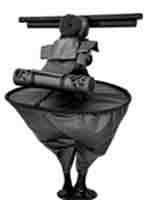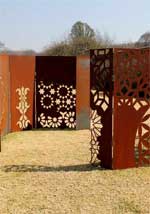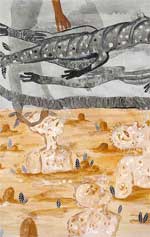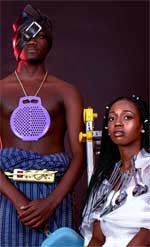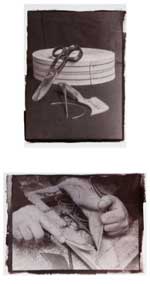
This LAB entry examins the concept of collective memory discussing art works from the respective exhibition on EVC's website (Link) against theories developed by scholars over the last few years.We do this in four sections:
- How do the artists understand the notion of "collective"? (See below.)
- How do they understand "memory"? (Go directly to this section.)
- What artistic strategies do they use when dealing with the theme? (Go directly to this section.)
- What theory is helpful in understanding the concept of collective memory? (Go directly to this section.)
Introduction
‘Walking’ through the exhibition on the website with 67 works, a visitor is left wondering what connects these works – so different are the ways in which the artists deal with the subject of collective memory. Thus, we try to map the field of different artistic approaches across all country contributions. Our mapping follows three guiding questions in two categories (see figure above).
- The first category (upright, in red) addresses the broad variety of artistic strategies deployed by the artists to deal with the topic of collective memory. An artist can express it, spread it, circulate, look for, connect to other meanings, reflect, bring to life, explore, research, try out, experiment, criticise, transform, create, invent, master, overcome and so on. Each work in this exhibition takes another course. We reduced the complexity to two a bipolar scale that ranges from representing what was experienced to (co-)creating a narrative that shall be experienced by a collective.
- The second category (horizontal, in blue) covers the topic of collective memory in two subcategories: What is ‘collective’ and what is ‘memory’?
- Collective: There is a broad range of understandings what ‘collective’ could mean, family, community, ethnic group, nation, a postulated cultural identity like 'African' or a religion. There are real or constructed, actual or imagined groups. We reduce this complexity to two aspects: existing groups that are socially formalised (like family or nation) and ‘conceptualised groups’ that are culturally constructed (like Global South).
- Memory can be related to events or to narratives (such as ‘national identity’). They can be fictional, they can be condensed experience (like slavery), transformed or faked interpretations of what happened.
Categories of 'collectives'

Formal groups, large or small
Cow Mash, Lerotse III: In Lerotse III, Cow Mash from Pretoria, South Africa, refers exclusively to her own family which, in the artist's commentary, is described as matrilineal and traced back to her great-great-great-grandmother. In this commentary, however, Cow Mash not only tells her story of the family, but she mirrors and merges this narrative with the story of the production process over the years - via the metaphor of "chewing the cud". Since it is cows that ruminate, the product also takes on the visible form of a cow. And this process of mirroring and merging then also leads to her adopted stage name "Cow Mash". All distinctions thus dissolve in an interweaving of all layers, which are always charged with the same meaning.
Here, the working process and the final work (with their associated wishes and desires) obviously steer and shape, perhaps even create the memory. The collective (familial) memory would then be the product of artistic engagement. Cow Mash’s comment that she is "reflecting on the thoughts and memories that create that artwork" could then be modified to: "reflecting on the collective memory thoughts and memories that the artwork creates". Art plays an active role in the formulation of collective memory through interventions that might be fiction or that might have a base in reality, at least in micro-areas. The work invites us as viewers to think of ourselves in larger contexts, as part of a collective and at the same time as (re)formulators of these very memories.
Esther Kute, A Kenyan Savannah: Esther Kute from Nairobi, Kenya, refers in her work to her country, her nation. The colours of the Kenyan national flag lie beneath a zebra pattern which in turn refers to the "magic of Kenyan national parks" (Esther Kute in her comment). Symbolic compression with strong reduction, like a logo, woven as a tapestry. She wants to "capture the essence of a country in an art piece"(Esther Kute in her comment) and at the same time express her love for her country. The reference that constitutes the collective here is the nation into which one (she) was born and into which the conception of self is woven. The difference from the example above is obvious in respect of the leading question what collective can mean. It can be small or large, private or public, a family or a nation. But in both cases, we have clearly defined groups with unambiguous affiliation and high stability of members. However, their cohesion and integrative power can always be at risk, as they do not necessarily offer identities that are accepted by all (Tajfel 1978).
Esther Kute's work (like Cow Mash's work), however, condenses what is common. But beyond that – as a tapestry – the work is hung and becomes part of the social space (whether in the family or in a more public place). In this space, it is a patriotic statement that is, in comparison with a hung flag, softened by the decorative design and the material. A good example of the communicative, sometimes even appellative function of art works in the context of collective memory.
Groups focused on the spiritual
Shenaz Mahomed, The Quran and Jihad approx. 164 and The Quran and Peace approx. 291 (detail): The work by Shenaz Mahomed from Pretoria is the only example (out of a total of 67 work) that deals with religion (here Islam) in an explicit way. In her work the two big steel pieces follow the design of traditional Quran book covers. For the patterns the artist counted the number of verses in the Quran that mention jihad (war) and peace respectively. She found that peace is mentioned almost twice as often as war. This numerical ratio is used to decide on the numbers of the patterns on the two steel sculptures, one for jihad, one for peace.
As in the example of Esther Kute above, Shenaz Mahomed situates her work into the social space. Yet she does it more massively and conspicuously by directly intervening in the public space with a clear message. This message corrects or subverts the existing, dominant narratives about violence and Islam – through an artwork. In this case art plays an active role not only in the continuation of collective memory but has also a specific power to visually shape counter-designs and thus to develop new or alternative collective memories. This becomes clear when she states in her comment that her piece is “cheekily” introducing the viewer to a “specific content”. Even though the work takes such an independent creative position, it is still and ultimately about belonging, about the commitment to a community – as in the next example.
William Bakaimo, Reconnexion aux ancêtres (Reconnection to the ancestors – detail): The Cameroonian artist William Bakaimo paints with liquid material (acrylic and ink) on canvas. In the flowing act of painting on a very large canvas, a world starts to grow. It grows as if by itself, in which human bodies, plants, sky and earth organically merge and grow apart, connect and separate. In his comment he calls this “nature” and talks about symbolisation of “the ancestors who speak to us through the elements that make up the universe”. And he stresses that we have this knowledge from African societies of the past. In this context, William Bakaimo’s way of making art could be understood as a “recalling [of] certain ancient practices” (William Bakaimo in his comment), not only to reconnect to precolonial knowledge but also to the ancestors, as the title of his work states.
William Bakaimo’s work is a good example of a reference to a collective that is not formalised nor clearly defined and demarcated, namely African societies of the past. The ancestors of African societies can be said to form a collective based on the knowledge systems passed down by them and which are remembered by Africans today. Collective memory, knowledge systems and nature merge in the art William Bakaimo is practicing. His artistic practice is not only a form of reviving, re-enacting, evoking but also of unfolding this collective memory.
Implicit / unconscious belonging
Josué Mimshe, Le royaume africain (African Kingdom): In an example from Cameroon, Josué Mimshe from Douala presents a very contemporary concept of African identity, compared with the painting by William Bakaimo we just discussed: the narrative of global capitalism with its consumer culture, communicated through household items such as aluminium ladders, plastic strainers, extension cords, etc., overlaps with historical, perhaps even mythological narratives from Africa, as in William Bakaimo’s work. Not only the title (African Kingdom) but also the majestic staging of the characters and the composition of the photo address the latter.
In the work, both narratives overlap and complement one another without negating the contradiction. Indeed, the artist even emphasises it. Through this the work becomes a hybrid, a bricolage, a form rooted in the creolisations of everyday life and pop cultural aesthetics as well as in venerable historical patterns. In this case, collective memory in art becomes an instrument to comment on the impact of modernity by combining old narratives with new forms, new ways of thinking, and thus continues to write collective memory. The publication of Josué Mimshe’s photo on the cover of an American (!) journal is testimony to this.
Regine Schurig, Arts and Crafts: For her Arts and Crafts series, Regine Schurig from Augsburg/Germany has selected photos that show traditional handicraft tools, hands of older people working with the tools, and the products. Her choice of artistic technique is fitting: black-and-white photographs produced by using a salt printing process with borders that themselves tell of their handicraft production. This picture out of the series shows the processing of an upholstered and spring seat. The hands remind me [Ernst Wagner] of my grandfather, I recognise him, although of course he is not. I feel at home, in Central Europe, being sure that a similar artistic approach from e.g. Central Africa would look differently.
The title Arts and Crafts, however, conceals this and thus raises the activity to the level of an archetype of human activity (even if the metal springs shown are of industrial origin): what we use every day has been made by hands and maintained over generations through repairing. The counter-model would be the plastic strainers, presented by Josué Mimshe. This product is standardised, industrially fabricated, mass-produced worldwide and impossible to repair.
Regine Schurig's work conjures up a world that seems to be disappearing and may soon only be found in collective memory: a world of handicrafts, of the production of individually different items in an aesthetic with visible regional and social roots – and this is important in our context of looking for the respective collectives addressed. The experience of a world of differences is expressed in the photo. The artistic representation ennobles the memory of the immediately familiar in a specific, but nearly invisible context (for me as a European it is just familiar) through an appreciative aesthetic.

